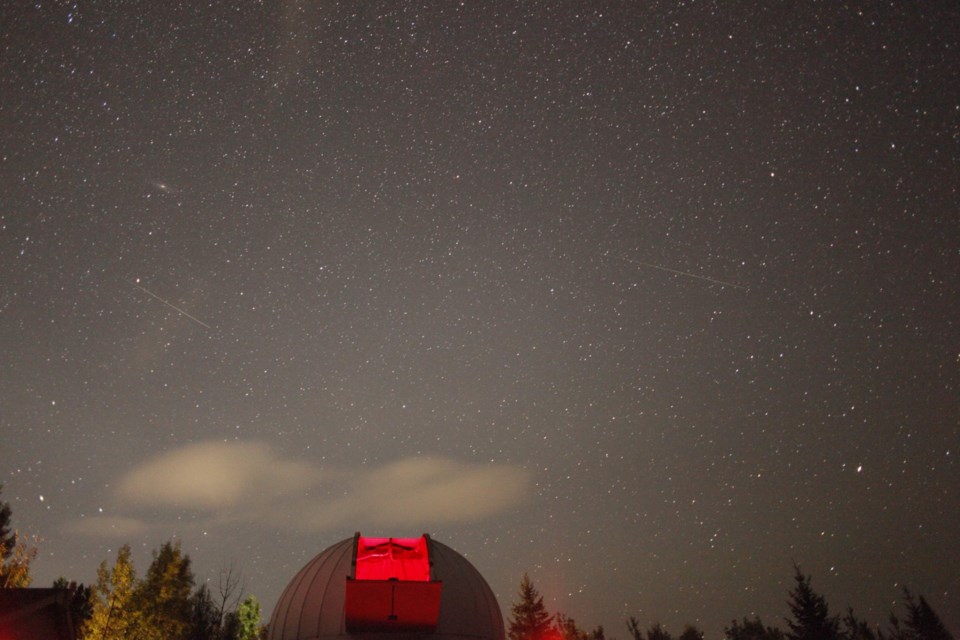The Prince George Astronomical Observatory is opening its doors on Tuesday, Aug. 12 and Wednesday, Aug. 13 — both nights at 8:30 p.m. — for the public to watch the Perseid meteor shower.
People are invited to bring their blankets and watch 60 to 90 meteors fly overhead every hour. Entry is by donation, at $2 for individuals and $5 for families.
The observatory is located at 7365 Tedford Rd.
Prince George Astronomical Society president Malhar R. Kendurkar spoke with The Citizen about some of the science behind the event.
“The Perseids meteor shower is one of the most prominent — or you could say, prolific — meteor showers for the entire year,” said Kendurkar. “And this meteor shower is associated with the comet Swift-Tuttle, or 109P.
“What’s happening is the comet orbits our sun, and then the debris left by this massive 26-kilometre-diameter comet — we are passing through that debris field left by the comet — that’s when we are actually seeing all these meteors. So that’s the Perseids meteor shower. And the meteor shower is actually visible from anywhere from mid-July to late August, but the peak is actually on Aug. 11, 12 and 13."
Kendurkar will also be hosting a presentation at 8:30 p.m., detailing more information about the interactions between the larger comet and the debris field and much more.
He added that usually around 400 people attend the event and that he is looking forward to sharing this experience with them.
“I’m very excited," he said. "Every year when we open the observatory for the first time, we are always excited to see how people come in and see the telescope, look at the meteor shower and talk with people. It’s always an exciting event at the observatory for us to host and let the community be part of the event and enjoy the meteor shower with us.”
- WEATHER: After a high of 23 C Tuesday, with a chance of showers, expect some clouds at night with a low of 10 C. Wednesday will have a daytime high of 20 C with a chance of showers, but with clear skies after dark with a low of 7 C.
The observatory is not just for show, as it provides students at CNC and UNBC valuable volunteer and learning opportunities, as well as providing tours for students from local schools.
In addition, valuable astronomical research is being conducted at the observatory, with Kendurkar himself making a few significant discoveries.
“I started supernova search in 2018, and using the 24-inch telescope,” said Kendurkar. “I discovered about four novae in the Andromeda Galaxy and 13 supernovae. This telescope — it’s a high-quality telescope — and we have research-grade instruments as well. We have a good charge-coupled device camera. Once in a while, if the weather permits, we also look at asteroids and comets to calculate those celestial mechanics and orbital mechanics.”
Kendurkar hasn’t just limited his search to the Andromeda Galaxy. During COVID-19, with his additional free time, he observed approximately 14,500 galaxies and, in the process, discovered 94 supernovas — a feat never before achieved by a Canadian.
His scientific research and contributions to the field have certainly gotten him noticed, as he has recently had an asteroid named after him.
“One of my mentors and a very close friend, Dave Bailam — we worked together on our research project and optical transient survey — he emailed me on July 21,” said Kendurkar. “I just got home from work and I checked the email. Firstly, I didn’t believe the email about the asteroid — because these are the things you never expect. That someone will name an asteroid after you — because these are very rare — and it’s very humbling. Things that very few get to experience and have. And getting that asteroid named after my last name — it’s not just honouring me, but also my entire family, including my wife, which is quite significant.”
Asteroid 541801 Kendurkar is approximately 750 metres in diameter, orbiting in the main belt part of our solar system. Kendurkar noted that it will be observable shortly before the end of the year.
As well, the Prince George Astronomical Society is looking to upgrade part of its telescope — something they will need local help to fund — making this upcoming meteor shower viewing a chance to contribute.
“Right now, we are working on making the 24-inch telescope fully robotic,” said Kendurkar. “But due to a lack of funding, we are always looking for donations, so we can actually promote science in Prince George and the area. And help people look at the night sky and learn their place in the universe.”



